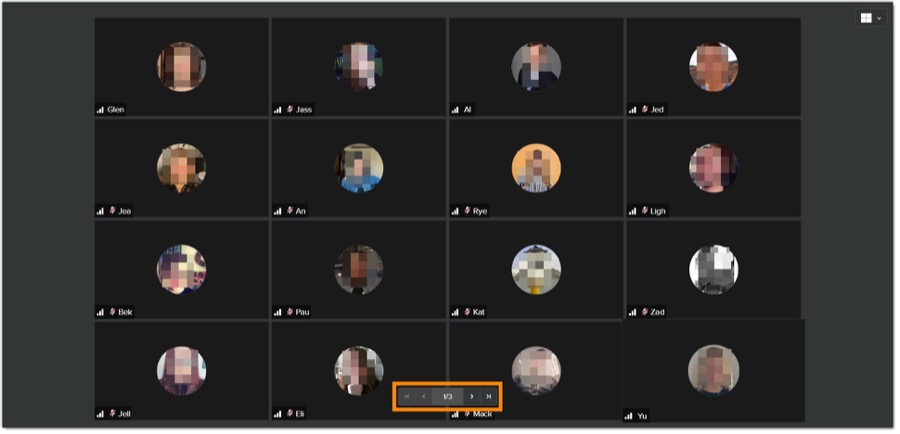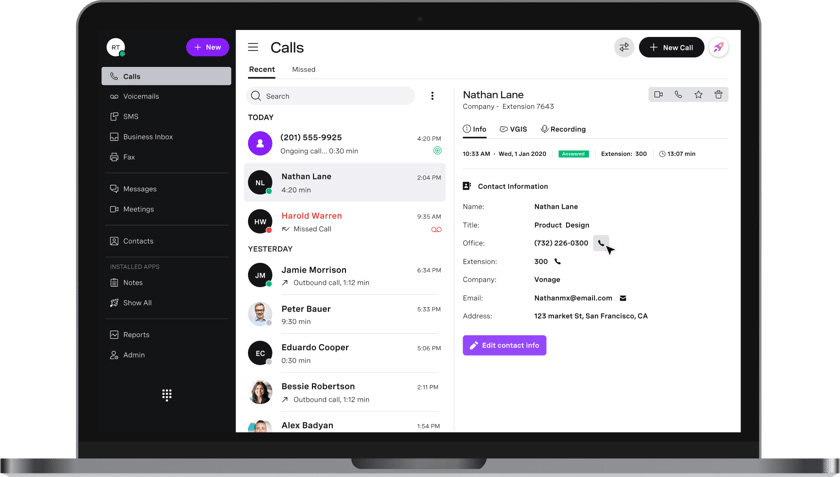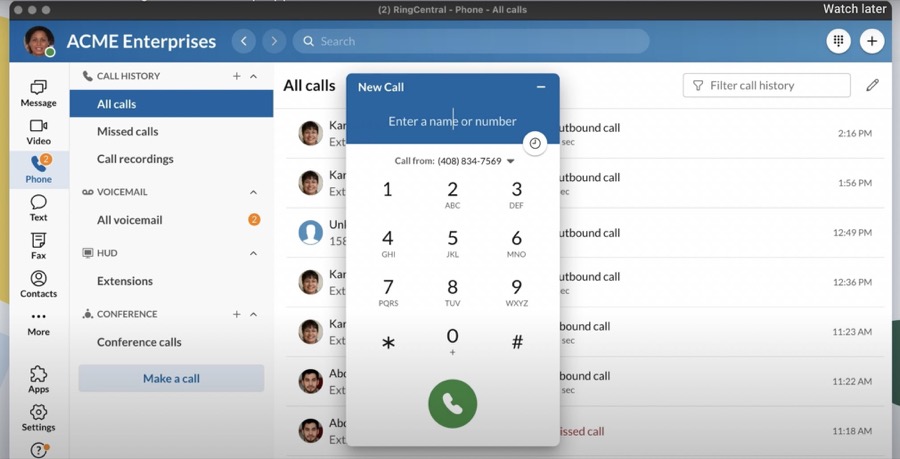RingCentral and Vonage are both leading business phone service providers. When comparing the two solutions, RingCentral provides more robust features, especially for call handling and video conferencing, and offers far more integrations. On the other hand, Vonage plans are slightly more affordable, and its advanced virtual assistant features can analyze sentiment.
Based on our comparison, the best use cases for RingCentral vs Vonage are as follows:
- RingCentral: Better for businesses that want a unified communications (UC) solution for voice, text, fax, and video conferencing with the most advanced features and integrations
- Vonage: Better for small businesses that want an affordable, easy-to-use unified communications as a service (UCaaS) solution that leverages artificial intelligence (AI) for call handling and management, efficiency, and insights
RingCentral vs Vonage at a Glance
RingCentral vs Vonage Pricing & Features | ||
|---|---|---|
Starting Price | $30 per user | $19.99 |
Free Trial | ✓ | ✕ |
Unlimited Domestic Calls & Short Message Service (SMS) Texts | ✓ | ✓ |
Team Messaging | ✓ | ✓ |
Video Conferencing | 200-participant cap | 100-participant cap |
Integrations | 200+ integrations | 17 integrations |
Advanced Features | Voicemail transcription, call monitoring, high-definition (HD) audio and video, single sign-on (SSO), and real-time analytics | Call flip, AI virtual assistant, HD voice, music on hold, SMS automation, and voicemail-to-email |
Uptime Service Level Agreement (SLA) | 99.999% | 99.999% |
Customer Support | 24/7 chat and phone support | 24/7 chat and phone support |
For More Information |
Want to learn more about these two providers? Check out our in-depth RingCentral review and Vonage review and know all about their pricing plans, key features, and best use cases.
Best Alternatives
RingCentral vs Vonage are two of the best business phone systems offering call management and UC features. However, they only offer 200- and 100-capacity video conferencing, respectively, and lack unmetered international calling. Here are some alternatives that might serve your company better, if you’re looking for a larger video capacity, unlimited international calling, or a straightforward phone system.
A few Vonage and RingCentral alternatives include:
- Nextiva: Nextiva and RingCentral have comparable features and pricing. However, Nextiva delivers a better video conferencing experience (with 250-participant caps and unlimited durations) and improved customer support across all plans. Monthly plans start at $30.95 per agent, monthly. Find out more in our RingCentral vs Nextiva review.
- Dialpad: Dialpad is a simple voice-over-internet- protocol (VoIP) service with plans starting as low as $23 per user, paid monthly. It doesn’t offer the advanced functionality that Vonage and RingCentral do, but it provides users with similar user interface tools at a more budget-friendly price. Plus, like Vonage, Dialpad has AI to improve caller and customer experiences. Our Dialpad vs RingCentral article explains more.
- 8×8: As you’ll read in our RingCentral vs 8×8 comparison, 8×8 offers the same communication channels and similar advanced functionality, but it’s the best VoIP service for international calling. Upgrade to 8×8’s X4 plan, with a monthly price tag of $57 per user, to unlock unlimited voice calling to 48 countries.
Best for Pricing: Vonage
Monthly Plans* (per Line)
*Pricing is based on one to four users and is exclusive of taxes and fees. | Monthly Plans** (per User)
**Pricing is for one to 20 users and can save up to 40% with annual billing. |
Vonage plans are more budget-friendly for just $19.99 per user, monthly. This is nearly half the price of RingCentral’s base price for monthly billing. Its highest tier is $39.99 per user, while RingCentral’s Ultimate plan is far more costly at $62.99 per user. However, it’s not an apples-to-apples comparison, as users get more features and functionality for their money on RingCentral’s plans.
For example, both providers offer unlimited domestic calls and texts in the U.S., but RingCentral covers the U.S. and Canada. Likewise, Vonage’s Premium and RingCentral’s Standard plans introduce video conferencing, but Vonage only allows up to 100 participants, while RingCentral’s video participant cap is twice as high. And as we cover below, RingCentral offers far more integrations.
Despite the head-to-head value difference, many businesses appreciate Vonage’s a la carte pricing options. Instead of forcing you to pay a premium for features your business might not need, such as toll-free numbers, call recording, visual voicemail, and upgraded tech support, Vonage provides low-cost plans with optional add-on features.
Best for UCaaS Features: RingCentral
RingCentral provides greater meeting capacity, unlimited storage, hotdesking, SSO, and real-time analytics. | Vonage offers status indications, call handling, advanced call routing, and AI assistance. |
Both providers offer essential UCaaS communication channels, including business voice calling, texting, audio conferencing, video conferencing, team messaging, and faxing. However, RingCentral beats Vonage in this category because it provides better call handling and phone system management features. It offers multi-level IVR, overflow call queues, and real-time analytics. RingCentral plans also allow you to assign extensions.
Vonage offers fewer UCaaS features than RingCentral but still delivers beyond the essentials. Vonage users get status indications, call handling (monitor, whisper, and barge), advanced call routing, and artificial intelligence (AI) assistance. While RingCentral offers most of these features, it’s only beginning to incorporate AI into its tools.
Do you want to know how UCaaS differs from CCaaS? UCaaS and contact center as a service (CCaaS) are cloud-based solutions with voice, video, and messaging capabilities. Their main difference is that UCaaS focuses on team collaboration, while CCaaS is geared toward sales and customer support. Read our UCaaS vs CCaaS guide to learn more.
Best for Video Conferencing: RingCentral
RingCentral provides a 200-participant meeting capacity and HD (high definition) audio and video. | Vonage provides a 100-participant meeting capacity and offers HD voice as an add-on. |
RingCentral delivers one of the highest-quality video conferencing solutions of any of the top business phone systems. Users get HD audio and video functionality and support for up to 200 participants. Participants can adjust their settings to view up to 25 screens simultaneously in the gallery view.

View up to 16 or 25 meeting participants using RingCentral, depending on your computer system. (Source: RingCentral)
RingCentral offers some niche video conferencing functionality that other UCaaS providers have yet to match. For example, the recently introduced Team Huddle feature enables users to host a persistent video meeting that colleagues can wander in and out of, reminiscent of the ability to interact in a physical environment. RingCentral Video also features one-click call-to-video and smartphone remote controls.
Vonage’s video conferencing solution allows users to host meetings with up to 100 participants. However, the quality is lacking next to RingCentral. HD video isn’t offered, and HD voice is only provided as an add-on at an additional cost. While Vonage doesn’t list the price of this add-on, its HD voice feature page indicates users can purchase three different tiers of audio quality.
Best for Artificial Intelligence: Vonage
Vonage’s AI virtual assistant answers phone calls, facilitates conversations, analyzes customer sentiment, transcribes conversations, and takes notes in real time. | RingCentral’s AI auto-follows where you are in a video meeting to keep you in the center of the screen and automatically adjusts lighting to present you at your best. |
The new AI virtual assistant in Vonage’s business phone system streamlines workflows and facilitates conversations without human interaction. The virtual assistant can answer phone calls, analyze customer sentiment, answer questions, and route calls to a live agent when necessary. It will even automatically transcribe conversations and take notes.
RingCentral’s integration of AI is further behind, but the company has acquired more smart technology recently and is building out new functionality. Currently, RingCentral uses AI to improve video meetings by auto-tracking the presenter and automatically adjusting the lighting.
RingCentral recently introduced live transcription and meeting summaries features for video meetings. AI live transcription converts speech or audio into a text document, while meeting summaries are reports of the discussions, specifically keywords, dates, action items, and takeaways.
Best for Integrations: RingCentral
RingCentral connects with over 200 third-party applications. | Vonage integrates with over 20 popular integrations. |
When it comes to integrations, RingCentral is the leading VoIP solution, not just compared to Vonage, but compared to most VoIP and UCaaS providers. Businesses can connect RingCentral to just under 300 applications, ranging from customer relationship managers (CRMs) to customer support tools to analytics software. If there’s a tool you want to connect to your business phone system, there’s a good chance RingCentral supports it.
While Vonage doesn’t offer the massive app gallery that RingCentral does, it still provides top-notch integrations with leading business applications. These applications include Salesforce, Microsoft, Google, HubSpot, Zapier, and Zendesk. In addition, Zapier can be used to facilitate thousands of integrations. Check out Vonage’s UC integrations and RingCentral’s App Gallery published by each provider to make sure it connects with the apps your business relies on.
Best for Ease of Use: Vonage
Vonage users enjoy a simple, clean interface across mobile and desktop applications. | RingCentral has a modern user interface, but the abundance of features can be overwhelming. |
Vonage is the better platform for businesses that prioritize simplicity and ease of use. Users find the applications easy to navigate, and Vonage provides the documentation needed to help its customers self-serve. Its knowledge base covers what you need to get started, how to manage the Vonage business phone system, its features and settings, and technical support.

Vonage’s Desktop App unifies calling, messaging, video conferencing, and business applications into one platform. (Source: Vonage)
On the other hand, RingCentral also provides a modern, easy-to-use interface. The main reason Vonage wins for ease of use is that RingCentral’s features are more robust, so it can take longer to navigate the platform to find the exact tool you need.

Easily make calls during the RingCentral desktop app. (Source: YouTube)
The learning curve for RingCentral is also higher for the same reason―the sheer number of tools and features to explore and configure. RingCentral University is the knowledge base that houses documentation for basic and advanced features and is broken down for general users and administrators.
Best for Customer Support: Vonage
Vonage has 24/7 customer support for U.S.-based customers and tech support for all its plans. Its service channels include email, live chat, phone, and community resources. | RingCentral offers 24/7 customer support across multiple, including phone, live chat, and social media. |
RingCentral and Vonage offer 24/7 customer support services through ticketing, phone, email, live chat, and community resources. However, Vonage edges out RingCentral in this area because its 24/7 customer support is available for all plans. On RingCentral, unlimited chat and phone support are only for the Premium tier and above.
However, RingCentral has its strengths. In addition to U.S. phone support, RingCentral caters to its global client base through dedicated phone support in Canada, Australia, New Zealand, Europe, and Asia. RingCentral users with complex issues that are not sensitive have the option to use its ticketing system and file a case online.
Both platforms also offer non-English phone support. RingCentral’s non-English support is available Monday-Friday, 9 a.m. to 6 p.m. Central European Time (CET), while Vonage’s Spanish hotline offers longer hours, from Monday to Saturday, 9 a.m. to 8 p.m. Eastern Time.
Frequently Asked Questions (FAQs)
Can I purchase supported phone devices?
Yes, both RingCentral and Vonage sell VoIP-enabled phones. Vonage supports Cisco, Grandstream, Panasonic, Polycom, and Yealink phones. RingCentral supports ALE, Avaya, Cisco, Polycom, Unify, and Yealink phones.
Do both providers offer virtual receptionist services?
Yes. In our RingCentral vs Vonage comparison, we found both providers offer customized virtual receptionist and call routing solutions. Both platforms allow users to configure their system based on operating hours and scheduling scenarios.
Does Vonage have 3-way calling?
Yes. Vonage users can initiate a conversation and call an additional phone number to expand the call to three separate lines.
How We Evaluated RingCentral vs Vonage
In this comparison, we looked at the key features of a cloud-based communications system, specifically pricing, video conferencing, AI, integrations, ease of use, and customer support. Then we compared how Vonage and RingCentral performed in these categories to help determine the best option for your small business.
Here’s a complete breakdown of these factors:
- Pricing: We compared the features offered under each pricing tier and the value for money of each option. We also looked at whether the provider offers free trials and whether they offer annual and volume discounts. Lastly, we compared add-on pricing to determine if a la carte options make either provider more affordable.
- General features: We analyzed the features and functionality of both VoIP phone systems to see if it provides fundamental features like an automated attendant, call recording, audio and video conferencing, and voicemail transcriptions.
- UC tools: Business phone systems are crucial to a company’s tech stack. We considered the UC tools it offers, such as single sign-on (SSO), call monitoring, and team messaging. Another critical tool we considered was the quantity and quality of integrations to determine which provider integrates best with other third-party software.
- Expert score: We tested the products ourselves to evaluate the user interface and experience. We also reviewed the setup process to see which is faster and simpler to get up and running.
Bottom Line
Vonage vs RingCentral was a close match-up, but Vonage won overall because of its budget-friendly pricing and top-notch AI capabilities. It’s also more user-friendly and provides comprehensive customer support. However, those who require more extensive app integrations and advanced UCaaS features are better off with RingCentral.